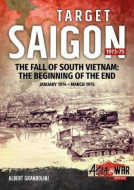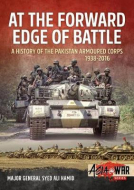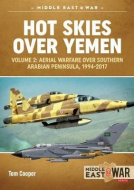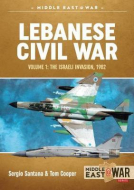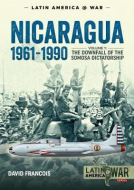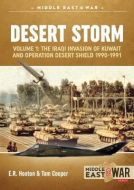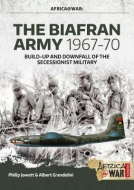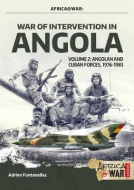
- Agriculture
- Architecture & Design
- Arts & Photography
- Biography
- Business
- Calendars and Diaries
- Childrens (All)
- Childrens (Illustrated)
- Childrens (Picture flats)
- Childrens (Te Reo)
- Classics
- Cooking, Food & Drink
- Craft & Hobbies
- Design (Art / Graphics)
- Design (Interiors)
- Education
- Fashion
- Fiction & Literature
- Fiction - Young Adult
- Gift Ideas
- Health & Wellbeing
- History
- Home & Garden
- Humour & Gift
- Instead of a Card Poems
- Military
- Music
- New Zealand
- NZ (History)
- NZ (Landscapes)
- NZ (Pictorial)
- Poetry
- Reference
- Religion & Faith
- Science & Nature
- Sport & Recreation
- Stationery
- Taschen : 40th Anniversary Edition
- Taschen : BA Basic Art
- Taschen : BU Bibliotheca Universalis
- Te Reo Māori
- Transport
- Travel
Military (455)

|
Wars and Insurgencies of Uganda (Africa@War 23)
ISBN: 9781910294550 Authors: Tom Cooper, Adrien Fontanellaz Publisher: Helion & Company In 1971, Idi Amin Dada, a former officer of the King's African Rifles and commander of the Ugandan Army, seized power in a military coup in Uganda. Characterize... In 1971, Idi Amin Dada, a former officer of the King's African Rifles and commander of the Ugandan Army, seized power in a military coup in Uganda. Characterized by human rights abuses, political repression, ethnic persecution, extra judicial killings, nepotism, corruption and gross economic mismanagement, Amin's rule drove thousands into exile. Amin shifted the country's orientation in international relations from alliances with the West and Israel, to cooperation with the Soviet Union. With Tanzanian leader Julius Nyerere offering sanctuary to Uganda's ousted president, Milton Obote, Ugandan relations with Tanzania soon became strained too. Already in 1972, a group of Tanzania-based exiles attempted, unsuccessfully, to invade Uganda and remove Amin. By late 1978, following another attempted coup against him, Amin deployed his troops against the mutineers, some of whom fled across the Tanzanian border. The rebellion against him thus spilled over into Tanzania, against whom Uganda then declared a state of war. Opening with an overview of the ascent of crucial military and political figures, and the buildup of the Tanzanian and Ugandan militaries during the 1960s and 1970s, this volume provides an in-depth study of the related political and military events, but foremost of military operations during the Kagera War - also known as 'A Just War' - fought between Tanzania and Uganda in 1978-1979. It further traces the almost continuous armed conflict in Uganda of 1981-1994, which became renowned for emergence of several insurgent movements notorious for incredible violence against civilian population, some of which remain active in central Africa to this day. This book is illustrated with an extensive selection of photographs, color profiles, and maps, describing the equipment, markings, and tactics of the involved military forces. Bind: paperback Pages: 72 Dimensions: 210 x 300 mm Publication Date: 20-01-2016 |
$49.99 |
|
Target Saigon 1973-75 Volume 2 (Asia@War 16)
ISBN: 9781911512929 Author: Albert Grandolini Publisher: Helion & Company After 27 years of conflict it seemed that peace would finally settle on the Indochina peninsula on 27January 1973 with the signing of a peace accord in Paris. T... After 27 years of conflict it seemed that peace would finally settle on the Indochina peninsula on 27January 1973 with the signing of a peace accord in Paris. The North Vietnamese had previously launched their greatest offensive against South Vietnam but fell short of their objectives, the destruction of the Army of the Republic of Vietnam (ARVN) and the destruction of the Saigon regime. They now proposed, in exchange for the release of the US prisoners of war, the withdrawal of the remaining American forces in Vietnam. Far from feeling committed by the agreement, the Hanoi leadership prepared the next round, the ultimate conquest of South Vietnam now that Washington had completely evacuated its last troops from the country. That first volume sets the scene, by making an assessment of the situation on the field, in both tactical and strategic perspectives. It also examines the last episode of the US gradual withdrawal as well as the implementation of part of the Peace Accords with the removal by the US Navy of the mines sown by its aircraft from the North Vietnamese ports and inland waters. It then presents the respective opposing armed forces and will particularly focus on the North Vietnamese rebuilding after the havoc wrought by the American aerial campaign of 1972. Furthermore, the expansion of the famous Ho Chi Minh Trail, vital for the logistical support of the communist troops, is thoroughly detailed. The South Vietnamese on their part placed great emphasis on developing their own air force in order to try to replace the withdrawal of American airpower. Most at all, it also details the initial fighting that not only resumed but soon escalated into divisional-level battles where the South Vietnamese still prevailed. Bind: paperback Pages: 88 Dimensions: 210 x 300 mm Publication Date: 21-11-2017 |
$49.99 |
|
|
The Chaco Air War 1932-35 Latin America@War 5
ISBN: 9781911512967 Author: Antonio Sapienza Publisher: Helion & Company The Chaco War was probably the first "modern" conflict in Latin America where military aviation was widely used in all roles. Bolivia, as the reader will find o... The Chaco War was probably the first "modern" conflict in Latin America where military aviation was widely used in all roles. Bolivia, as the reader will find out, had a very powerful military air force, but unfortunately for them and luckily for Paraguay, its high army command did not take advantage of it. On the other hand, the Paraguayan Commander-in-Chief, General José Félix Estigarribia used military aviation to help him defeat the enemy on the ground, and the result was clear: the Bolivians were expelled from the Chaco after three years of war. Previous publications have focused on the Chaco Air War with the aircraft technical details and almost no information on aerial operations, which is this book's centerpiece. All dogfights and bombing missions mentioned are detailed including crews, aircraft, serials, places and outcomes. The book also describes how both military air forces were organized, how pilots and aviation mechanics were trained, how and where aircraft were purchased and many other unpublished before details. The maps included in the book will help the reader have an idea of where aerial operations took place, both combatants air bases, Bolivia's plan to conquer the whole region and how the Paraguayan Army finally expelled the enemy out of the Chaco. The text is supported by a large number of photographs, and specially commissioned color profile artworks from modelers. Bind: paperback Pages: 80 Dimensions: 210 x 300 mm Publication Date: 19-04-2018 |
$49.99 |
|
|
At the Forward Edge of Battle A History of the Pakistan Armoured Corps 1938-2016 Volume 1 (Asia@War 9)
ISBN: 9781911628071 Author: Major General Syed Ali Hamid Publisher: Helion & Company This is a well-researched and authoritative account by a military historian, Maj Gen Syed Ali Hamid. It embraces the evolution of the Pakistan Armoured Corps, i... This is a well-researched and authoritative account by a military historian, Maj Gen Syed Ali Hamid. It embraces the evolution of the Pakistan Armoured Corps, including its culture, organization, doctrine, equipment, operational performance, overseas deployment, garrisons, personalities and a myriad of events that together portray what and why the corps is at this point in time. Beginning with the mechanization of the Indian cavalry in 1938, it spans nearly 95 years and chronicles the corps remarkable growth. It narrates how a redundant horse mounted force went through various stages of metamorphosis, surmounted the challenges of Independence and transformed from a small supporting arm into the mechanized spearhead of the Pakistan Army. Its richness lies in the portrayal the Muslim clans that form the rank and file of the Armoured Corps, as well as tracing the development of its officer corps from its genesis and onwards through the Second World War and leading onto post-Independence. This includes an assessment of many personalities who performed a leading role in the development of the corps. It also provides an interesting insight into the culture of the Pakistan Armoured Corps which is a unique blend of values and traditions inherited from its predecessor, with those of a post-Independence national army. This highly informative book compliments publications on the Pakistan Army by elaborating on the role and structure of one of its principal arms. Since it covers in some detail the Pakistan-India conflicts, it also compliments books published by the Indian authors by presenting a view from 'the other side of the hill.' To place the evolution and development of the armored corps in context, the author has painstakingly researched and presented hitherto fragmented information on the Pakistan Army. Consequently the book also emerges as a work of value to an audience which is interested in how the Pakistan Army evolved and the milestones in its development. Having served in the Pakistan Army for 50 years, the author has a unique insight into the evolution of the corps and is linked with its past through his father Maj Gen Syed Shahid Hamid who was commissioned from Sandhurst into the cavalry of British India in 1933. Shahid was one of the pioneers of the Pakistan Army and the author of several books on political and military history of the sub-continent. The publication is liberally illustrated with a large number of photographs, many of them unpublished, which makes for very interesting reading. There is also a liberal use of maps to support the text. For a serious student of the military history of the Pakistan-India Subcontinent, this book is a major scholarly work with footnotes / endnotes, a bibliography of ten pages of primary and secondary references, and two large indexes. Bind: paperback Pages: 96 Dimensions: 210 x 300 mm Publication Date: 16-10-2019 |
$55.00 |
|
|
Hot Skies over Yemen Volume 2 (Middle East@War 14)
ISBN: 9781911628187 Author: Tom Cooper Publisher: Helion & Company Following the Civil War of 1994, Yemen experienced few years of relative peace. This was rudely interrupted in 2004, when the government opened the first of six... Following the Civil War of 1994, Yemen experienced few years of relative peace. This was rudely interrupted in 2004, when the government opened the first of six campaigns against the movement colloquially known as 'Houthis'. The Yemeni Air Force - partially re-equipped over the previous years - saw intensive involvement in this conflict, but proved insufficient. In late 2009 and through 2010, the war spread into Saudi Arabia, which reacted with its first military intervention in the country. A host of long-simmering internal conflicts culminated in the second Saudi-led military intervention in Yemen, launched in March 2015. Although run along widely accepted Western doctrine of aerial warfare, and highly effective, the campaign in question experienced a number of massive problems - primarily related to unexpected developments and extremely complex relations between multiple parties in Yemen. That the air forces of the Saudi-led alliance involved in the ongoing campaign in Yemen are operating some of most modern combat aircraft and weaponry manufactured in the West is no secret. But, exactly how, why, when, and where are they deploying weapons systems in question and for what purpose remains entirely unknown in the public. Thanks to approach to firsthand sources, this volume is providing answers to precisely these questions and thus providing an exclusive insight into the conduct of operations by such modern aircraft types like F-15S, F-16E/F, EF-2000 Typhoon, and Mirage 2000. Containing over 140 photographs, color profiles, maps and extensive tables, Hot Skies over Yemen is a richly illustrated and unique point of reference about one segment of modern aerial warfare that remains entirely unknown until today. Bind: paperback Pages: 84 Dimensions: 210 x 300 mm Publication Date: 29-08-2018 |
$49.99 |
|
|
Lebanese Civil War Volume 1 (Middle East@War 21)
ISBN: 9781911628200 Authors: Sérgio Santana, Tom Cooper Publisher: Helion & Company Formerly known as the 'Switzerland of the Middle East', an island of economic stability and social progress, Lebanon was shattered by a civil war that raged fro... Formerly known as the 'Switzerland of the Middle East', an island of economic stability and social progress, Lebanon was shattered by a civil war that raged from 1975 until 1990. Pitting the central government against different factions and alliances of Christians, Sunni and Shi'a Moslems, leftists, and Syrian armed forces, this multifaceted conflict experienced a major escalation when Israel launched an invasion with the aim of destroying the Palestine Liberation Organisation (PLO), in 1982. Also known as the First Lebanon War, or Operation Peace for Galilee, the Israeli enterprise was run in cooperation with Christian allies and the self-proclaimed Free Lebanon State. Except for attacking the PLO and surrounding its leadership in West Beirut, it provoked a major showdown with Syrian armed forces deployed inside Lebanon, and resulted in a series of bitter battles. Ever since, fighting on the ground and in the sky of the Beka'a Valley is a synonym for modern-day conventional air-land battle in the age of high-technology warfare. Focusing on military-related developments, and rich in exclusive details and illustrations, 'Lebanese Civil War: Israeli Invasion, 1982' is dissecting military forces, their equipment, intention and capabilities, and their combat operations. Bind: paperback Pages: 96 Dimensions: 210 x 300 mm Publication Date: 13-11-2019 |
$55.00 |
|
|
Nicaragua 1961-1990 Volume 1 (Latin America@War 10)
ISBN: 9781911628217 Author: David Francois Publisher: Helion & Company In the wake of the US invasion of Nicaragua in 1912, the country came under the rule of the Somoza family, which imposed a brutal and corrupt military dictators... In the wake of the US invasion of Nicaragua in 1912, the country came under the rule of the Somoza family, which imposed a brutal and corrupt military dictatorship. A low-scale insurgency of students, supported by peasants and other anti-Somoza elements of the society developed already in the 1960s. By the 1970s, the country became embroiled in a brutal insurgency. Supported by Cuba, a coalition of students, farmers, businessmen, clergy and a small group of Marxists launched a major war in 1978, which resulted in the downfall of the Somozas, a year later. The Sandinista government established in Managua of 1979 found the country ruined by the long war and natural disasters, and nearly half of the population either homeless or living in exile. Attempting to restructure and recover the underdeveloped economy, Sandinisas introduced a wide range of reforms and a cultural revolution. Considering the Sandinistas for 'Cuban-supported Marxists' and therefore a major threat for the US domination of Latin America, in 1980-1981 the USA began supporting the creation of the Contrarevolutionary forces (better known as 'Contras'), and thus helped provoke a new war that was to rage through Nicaragua for most of that decade, and is going to be covered in Volume 2 of this mini-series. Leaning upon extensive studies of involved armed groups, and their insurgencies in the 1960s and 1970s, 'Nicaragua, 1961-1990, Volume 1' provides an in-depth coverage of military history during the first phase of one of major armed conflicts of Latin America in modern times. Guiding the reader meticulously through the details of involved forces, their ideologies, organization and equipment, this book is offering a uniquely accurate, blow-by-blow account of the Nicaraguan War and profusely illustrated with more than 120 photos, maps, and color artworks. Bind: paperback Pages: 72 Dimensions: 210 x 300 mm Publication Date: 04-01-2019 |
$49.99 |
|
|
Desert Storm Volume 1 (Middle East@War 18)
ISBN: 9781911628224 Authors: E R Hooton, Tom Cooper Publisher: Helion & Company Early in the morning of 2 August 1990, aircraft of the Iraqi Air Force bombed Kuwaiti air bases, and then the Iraqi Republican Guards stormed into the country. ... Early in the morning of 2 August 1990, aircraft of the Iraqi Air Force bombed Kuwaiti air bases, and then the Iraqi Republican Guards stormed into the country. Thus began what would be called the 'Gulf War' - also the 'II Gulf War', and sometimes the 'II Persian Gulf War' - fought between January and March 1991. Although encountering some problems, the Iraqi forces occupied Kuwait in a matter of few days. However, when President Saddam Hussein of Iraq unleashed his military upon Kuwait, little did he know what kind of reaction he would provoke from the Western superpowers, and what kind of devastation his country would suffer in return. Concerned about the possibility of Iraq continuing its advance into Saudi Arabia, the USA - in coordination with Great Britain, France, and several local allies - reacted by deploying large contingents of their air, land, and naval forces to the Middle East. Months of fruitless negotiations and the continuous military buildup - Operation Desert Shield - followed, as tensions continued to increase. Determined to retain Kuwait, and despite multiple warnings from his own generals, Saddam Hussein rejected all demands to withdraw. The USA and its allies, 'the Coalition', were as determined to drive out the invader and restore Kuwaiti independence. Gradually, they agreed this would have to be by force. Following an authorization from the United Nations, the Coalition launched Operation Desert Storm, on 17 January 1991, opening one of the most intensive air campaigns in history. The last conventional war of the 20th Century saw the large, but essentially traditional, Iraqi Army overwhelmed by forces trained and equipped to exploit the latest technologies. Desert Storm reveals the whole war fought between Iraq and an international coalition, from the start of this campaign to its very end. Largely based on data released from official archives, spiced with numerous interviews, and illustrated with over 100 photographs, 18 color profiles and maps, it offers a refreshing insight into this unique conflict. Bind: paperback Pages: 112 Dimensions: 210 x 300 mm Publication Date: 13-08-2019 |
$49.99 |
|
|
The Biafran Army 1967-70 (Africa@War 47)
ISBN: 9781911628637 Author: Philip S. Jowett Publisher: Helion & Company Synonymous with the starvation that killed almost two million people, Biafra was a parastate that voted to secede from Nigeria in May 1967. Formally recognized ... Synonymous with the starvation that killed almost two million people, Biafra was a parastate that voted to secede from Nigeria in May 1967. Formally recognized by Gabon, Ivory Coast, Tanzania, and Zambia, and supported by France, Israel, Portugal, Spain, South Africa, Rhodesia, and even the Vatican, Biafra's attempt to leave Nigeria resulted in the Nigerian Civil War, which was to last until January 1970. Although lacking official support from abroad, the Biafran authorities quickly built up a military. Their efforts to set up an air force, supported by numerous Europeans - were widely publicized. Indeed, Biafra-related adventures of Polish World War II ace Jan Zumbach, or the Swedish pilot Carl Gustaf von Rosen reached the status of legends before long. Far less is known about the Biafran Army and Navy, their capabilities and intentions, or the conduct of their combat operations. Indeed, the establishment of multiple commando units, and a special guerrilla outfit designed to emulate the Viet Cong, but especially the local manufacture of weapons - including armored vehicles - remain largely unknown to the public. Based on years of thorough research, Biafran Army is the first work ever to offer a comprehensive, in-depth study of the build-up, training, composition, equipment, and combat operations of all the three branches - the army, the air force, and the navy - of the secessionist military during the Nigerian Civil War. Illustrated by more than 120 rare photographs, maps, and color profiles, this account provides a unique source of reference for enthusiasts and professionals alike. Bind: paperback Pages: 88 Dimensions: 210 x 300 mm Publication Date: 07-04-2020 |
$49.99 |
|
|
War of Intervention In Angola Volume 2 (Africa@War 34)
ISBN: 9781911628651 Authors: Adrien Fontanellaz, Tom Cooper Publisher: Helion & Company As of mid-1976, the civil war in Angola was seemingly decided: supported by a large contingent of Cuban forces, the MPLA established itself in power in Luanda. ... As of mid-1976, the civil war in Angola was seemingly decided: supported by a large contingent of Cuban forces, the MPLA established itself in power in Luanda. Its native competitors, the US-French-Zaire-supported FNLA, and UNITA, supported by China and South Africa, were in tatters. The French and Zaire-supported FLEC - an armed movement for the independence of the oil-rich Cabinda enclave - was in disarray. The last few of their surviving units were either driven out of the country, or forced into hiding in isolated corners of northern and southeastern Angola. Nevertheless, the war went on. The MPLA's government failed to decisively defeat UNITA, in southern Angola, and then found itself facing a coup attempt from within in May 1977. Crushed in blood, this resulted in thousands being jailed and tortured: many more escaped abroad, where they reinforced the ranks of the battered opposition. The coup prompted the Soviets to attempt increasing their influence with the aim of establishing permanent military bases in the country. While all such overtures were turned down, Angolan operations along the border to what was then the South-West Africa (subsequently Namibia) in October 1980, combined with the increased activity of SWAPO - an insurgency against the South African control of that territory - subsequently Namibia - prompted South Africa to launch another military intervention and resume supporting UNITA. In turn, this prompted not only the Cubans to further increase their military presence, but also the Soviet Union into delivering massive amounts of military aid to the government in Luanda. Angola not only assumed the role of one of the major hot battlefields in the Cold War: its 'civil war' saw a number of major showdowns between diverse belligerents, culminating in the Battle of Cangamba in 1983. Based on extensive research, with help of Angolan and Cuban sources, War of Intervention in Angola, Volume 2 traces the military build-up of the Cuban and Soviet-supported Angolan military, the FAPLA and its combat operations, and those of the Cuban military in Angola, in the period 1976-1983, their capabilities and intentions, and their battlefield performances. The volume is illustrated with over 100 rare photographs, half a dozen maps and 18 color profiles. Bind: paperback Pages: 80 Dimensions: 210 x 300 mm Publication Date: 11-07-2019 |
$49.99 |


